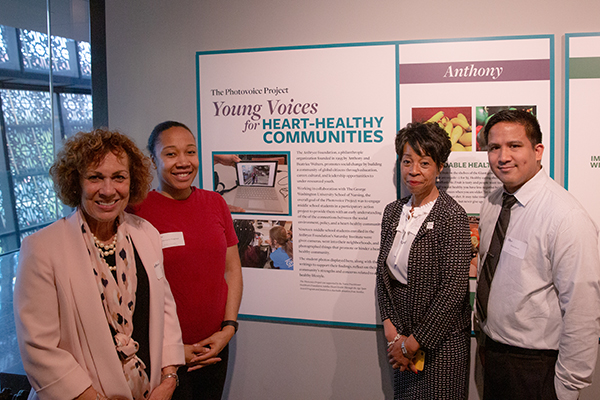Delivering high-quality health care requires knowing more than a patient’s blood pressure, heart rate and weight. People are more than these numbers: where they live, what they eat, whether they exercise also play a role in their health. This crucial lesson is imparted to GW Nursing bachelor of science in nursing (BSN) students through a participatory action research project conducted in partnership with the AnBryce Foundation. The project went on display this spring at the Smithsonian Institution's National Museum of African American History and Culture.
“During this project, our nursing students, along with the middle school student whom they taught, learned the importance of social determinants of health and how they can facilitate or impede the making of a heart-healthy community,” said Dr. Sandra Davis, the school’s assistant dean for diversity, equity and inclusion and one of three faculty members who received an award from the NPHF/Astellas Foundation to fund the project.
The middle-schoolers learned by completing a photovoice project, in which they explored and documented their surroundings by taking photos, wrote a commentary on what was unhealthy and noted how their environment could be made healthier.
“Children get used to what they see at home,” said Ms. Iris Fountain, a parent who attended the Saturday Institute PhotoVoice Exhibit held at Thurgood Marshall Academy Public Charter High School in December. Ms. Fountain took note that many neighborhoods in the D.C. area can have as many as three liquor stores on one block that open as early as 6 a.m. “If I notice, children notice it,” she said.
“The picture on the left shows people drinking liquor and throwing it away in the streets. This shows that there are drunk people who hang out in the community and that it is full of bottles of liquor. The photo can educate people in my community by showing what most people are hooked on and telling them to cut down the amount of liquor they consume. The picture on the right is an example of how to improve the community. For every one liquor store you have there should be one organic store too,” one student wrote.
Through this project, area middle-schoolers learned not only how to take care of themselves, but also how to advocate for and in their communities. GW Nursing BSN students guided the children, under instruction by Drs. Davis, Karen Dawn and Adriana Glenn, as part of the program’s community health portion.
Social and environmental factors such as education, housing, places to exercise and healthy places to eat, all matter when it comes to heart disease and risk factors for heart disease. Underrepresented groups, especially African Americans, suffer a disproportionate and risk factor burden for heart disease. In addition to being one of the poorest cities in the United States, the District of Columbia D.C. has one of the highest avoidable death rates from heart disease of all major U.S. cities.
Earlier this month, Ms. Fountain’s son wrote Maryland Governor Larry Hogan encouraging him to create more community gardens in public areas. This was their first activity with GW Nursing and the AnBryce Foundation, but will not be his last as he hopes to attend Camp Dogwood later this summer.


